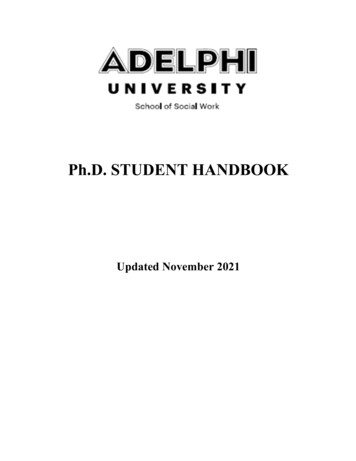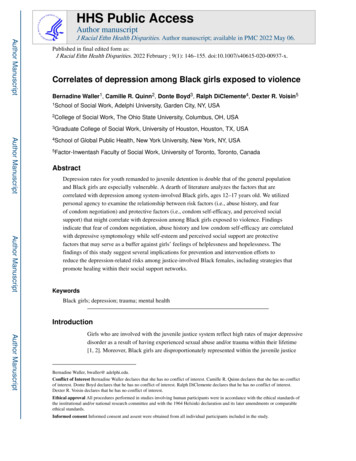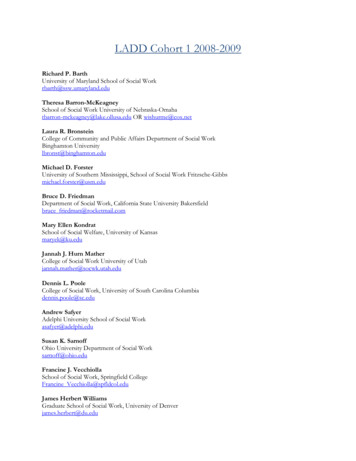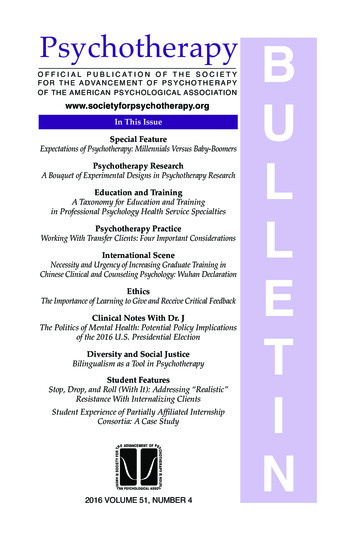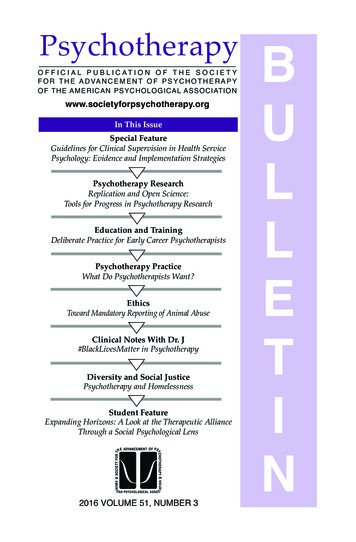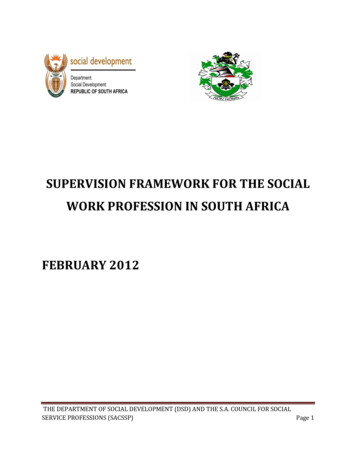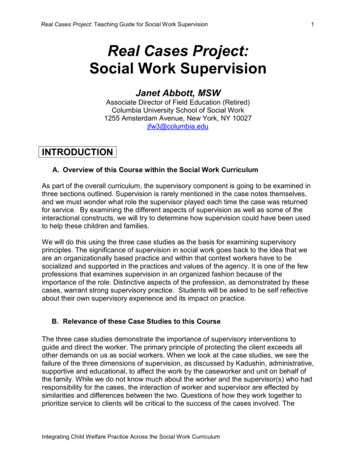
Transcription
Real Cases Project: Teaching Guide for Social Work Supervision1Real Cases Project:Social Work SupervisionJanet Abbott, MSWAssociate Director of Field Education (Retired)Columbia University School of Social Work1255 Amsterdam Avenue, New York, NY 10027jfw3@columbia.eduINTRODUCTIONA. Overview of this Course within the Social Work CurriculumAs part of the overall curriculum, the supervisory component is going to be examined inthree sections outlined. Supervision is rarely mentioned in the case notes themselves,and we must wonder what role the supervisor played each time the case was returnedfor service. By examining the different aspects of supervision as well as some of theinteractional constructs, we will try to determine how supervision could have been usedto help these children and families.We will do this using the three case studies as the basis for examining supervisoryprinciples. The significance of supervision in social work goes back to the idea that weare an organizationally based practice and within that context workers have to besocialized and supported in the practices and values of the agency. It is one of the fewprofessions that examines supervision in an organized fashion because of theimportance of the role. Distinctive aspects of the profession, as demonstrated by thesecases, warrant strong supervisory practice. Students will be asked to be self reflectiveabout their own supervisory experience and its impact on practice.B. Relevance of these Case Studies to this CourseThe three case studies demonstrate the importance of supervisory interventions toguide and direct the worker. The primary principle of protecting the client exceeds allother demands on us as social workers. When we look at the case studies, we see thefailure of the three dimensions of supervision, as discussed by Kadushin, administrative,supportive and educational, to affect the work by the caseworker and unit on behalf ofthe family. While we do not know much about the worker and the supervisor(s) who hadresponsibility for the cases, the interaction of worker and supervisor are effected bysimilarities and differences between the two. Questions of how they work together toprioritize service to clients will be critical to the success of the cases involved. TheIntegrating Child Welfare Practice Across the Social Work Curriculum
Real Cases Project: Teaching Guide for Social Work Supervision2critical issues in supervision outline what makes supervision work on behalf of clientsand what can go wrong.As we review the case material, each time the case is closed, there are unresolvedissues. Big question in these cases are who is responsible? and how can and shouldthe issues be resolved?C. Specific Learning Objectives Related to Using Cases in This Course To define and explain the purpose and function of supervision within the socialwork profession.To examine the supervisory relationship in the context of power, authority andparallel process with a focus on the impact on learning and teaching.To examine the role of the supervisor in the organizational context.To define how social workers use themselves to address issues of professionalresponsibilities and diversity in supervisory roles.D. Overview of what is included in this guideThis module of the overall curriculum will examine the following areas in regards to theimpact of supervision on the outcome of the cases. Outline some of the general principles of supervision Examine the impact of similarities and differences between workers andsupervisors Detail critical components of supervision that must be addressed for social worksuccess including relational issues and burnout.TEACHING STRATEGIESA. Strategy One: General Principles of Supervision1. Area/issue of the case studies to be highlighted:In each of the three cases there are opportunities for supervisory interventions onmultiple levels. With the exception of the “supervisory review”, there is nomention of the on-going supervision and impact of supervisory input. Let’s look ateach case in terms of why do we need supervisory control. Suggestion – breakclass into small groups and have them make this determination.2. Timing within the semester:This strategy can be utilized at the beginning of the semester when the class isreviewing the goals and principles of supervision and can be spread out overseveral class periods depending on the instructor’s needs/desires.Integrating Child Welfare Practice Across the Social Work Curriculum
Real Cases Project: Teaching Guide for Social Work Supervision33. Teaching methods:This strategy will incorporate multiple teaching methods including brainstorming,small group work, and lecture.Brainstorming What are supervisory controls? Which ones are pertinent inthe each of the three case studies?Lecturette (using the answers elicited and adding those missing andexpanding on where necessary)1. Accountability to the larger community:(The function of the agency is the protection of children. Wheninstances of abuse occur that result in death or serious harm,frequently there is an outcry and a new resolution by the agency tocorrect the deficiencies. Ex Nizxmary, Izquierda etc.)2. Accountability for implementing social policy:(The expectation that ACS will protect children and will provide familieswith service to overcome their complex issues)3. The complexity of the tasks - help the worker with consistency in anunpredictable world:(The caseworker in the Andrea R case faced the unpredictability ofmental illness and its impact on the family. What should theanticipatory guidance be to help the worker when in the field?4. Since the tasks take place in the field, it is critical to develop methodsof reporting that can protect the worker:(Protection is both on a safety basis and a legal basis.)5. Protection of clients!(The crux of the agency work is the protection of clients. In the Mary Scase, should the supervisor be involved to help ferret out what the realissues are to insure the protection of Jason? In the Andrea R case,how should the supervisor be assisting in the understanding of mentalillness and the parentification issues experienced by Vincent? In theAnne M case, how should the supervisor assist the worker in theengagement issues with Peter T?6. Enhance shared decision making:(Modeling: Had the worker and supervisor discussed these cases indetail, anticipated different interventions and outcome, it would haveserved as a model for work with clients.)Integrating Child Welfare Practice Across the Social Work Curriculum
Real Cases Project: Teaching Guide for Social Work Supervision47. The nature of if the issues make support desirable:(The complexity of dealing with domestic violence, mental illness andinadequate guardianship as well as other issues pertinent to thesecases, make it all the more important to have a shared decisionprocess. This does occur when there are the 72 hour meetings and thesupervisory review.) However, should this be occurring on amoreregular basis and how should it take place?8. Tarasoff – there needs to be an explanation and discussion ofvicarious liability:Brainstorming: Ask class about their experience in supervision. On a scaleof one to ten, one being dreadful and 10 being extraordinary, where is theirsupervisor? What makes it good/bad? Have they felt protected? Which ofthe above characteristics is part of their supervisory experience?Put questions on board for class to review.1. What are the different types of supervision?2. What are the goals and objectives of the different types of supervision?3. What are the supervisory tasks that each method employs?Lecturette (using the answers elicited and adding those missing)Administrative supervision Goals Overall, the long-term objective is to provide a systemiccoordination of effort by providing a set of rules that areapplied equally to all staff Short term objective provide worker the information necessary to work effectively TASKS Work planning Work delegation. Monitoring Evaluation Communication Advocacy Administrative buffer Change agentIntegrating Child Welfare Practice Across the Social Work Curriculum
Real Cases Project: Teaching Guide for Social Work Supervision5Educational supervision Goals this is about teaching the worker what needs to be known inorder to perform the job and includes the skills, knowledgeand approach to the work. Short term objective improve workers capacity to do an effective job TASKS Initial indoctrination –creating a common frame of reference Evaluating the absorption of information- allowing adiminishment of administrative controls Content areas regarding the clients, agency, process,problems/issues and personnel Purposeful and conscious use of self through self-reflectionSupportive supervision Goals according to NASW this provides the “management of workrelated stress and assistance to staff in coping with workrelated issues.” The importance of a workers psychologicalwell-being cannot be underestimated. Short-term objective if the worker can be positive about the issues being faced;the work product will be improved. TASKS Reassurance Encouragement Recognition of achievement Constructive criticism Realistic appraisals Ventilation Universalization Desensitizing Attentive listeningBrainstorming: What should supervision look like? When does it work?What makes it work?Break class up into groups so that you have one/two for each specific method ofsupervision. The group should answer the following questions depending on theirfocus. Using giant post-it sheets or a blackboard have groups report conclusionsand have the class come to consensus. By the end of this segment the classIntegrating Child Welfare Practice Across the Social Work Curriculum
Real Cases Project: Teaching Guide for Social Work Supervision6should be able to differentiate how to use aspects of supervision and identifywithin the case studies at least 3 to 4 instances where such supervision mayhave been effective.Where should the supervisor have used administrative controls andsupervision in each of the three cases? (These are clearly outlined in the casepresentations and come up as undone and unattended-to tasks)Where should the supervisor have used educational supervision in each ofthe three cases? (The educational supervision in these cases is on mentalillness, autism, domestic violence and family triangulation as well as thedevelopmental issues of both latency age children and adolescence. This willassist the caseworker in her engagement and contracting with the families.)Where should the supervisor have used supportive supervision in each ofthe three cases? (In the Andrea R and Mary S cases, assessing the criticalissues can be frustrating and supportive supervision becomes essential. In theAnne M case, a caseworker may need supportive supervision around the issuesof domestic violence.) In each of these cases the support is critical for the ongoing work on the part of the caseworker.LecturettePROCESS (of Supervision) Individual – principal; group for common tasks Time is scarce Preparation by both parties Opportunity for guided self reflection Techniques Modeling – especially as we begin to talk about parallel process Progression of learning – i.e. information to knowledge, knowledge tounderstanding, understanding to changes in behavior Peers and boundaries Styles FeedbackConstructive criticism is a critical component of all supervision. What doesconstructive criticism consist of?How To Provide Constructive Criticism As soon as possible Specific Objectifiable Descriptive rather than judgmental Highlight the effect of a good performance Focused on the behavior not the personIntegrating Child Welfare Practice Across the Social Work Curriculum
Real Cases Project: Teaching Guide for Social Work Supervision 7Offered tentatively for considerationFocus on what the supervisee needsShared ideas and alternativeCan be effectively absorbedClosure 4. Materials:Post-it sheets and markers or a blackboard with chalk for each group5. Supporting readings:Cohen, B.Z. (1999). Intervention and supervision in strengths-based social workpractice. Families in Society, 80(5), 460-466.Kadushin, Alfred, Supervision in Social Work, 3rd Edition, Columbia universityPress, 1992, Chapters 2,3,4Kurland, R. & Salmon, R. (1992). When problems seem overwhelming:Emphases in teaching, supervision, and consultation. Social Work, 37(3), 240244.Weinbach, Robert W. The Social Worker as Manager, Longman, 1990, Chapt. 6.Young, T.M. (1994). Collaboration of a public child welfare agency and a schoolof social work: A clinical group supervision project. Child Welfare, 73(6), 659669.6. Evaluation plan:A short paper assignment can be utilized to evaluate student learning. Studentsare asked to use the class discussions to determine what each of the case studysupervisors might have done and how he or she could provide constructivecriticism to the worker to provide guidance.B. Strategy Two: Similarities and Differences1. Area/issue of the case study to be highlighted:As in the previous strategy, the utilization of supervision during each of the threecase studies will be highlighted in this strategy.2. Timing within semester:This strategy can be utilized at any point during the semester when the instructorchooses to discuss learning styles as they relate to supervision.3. Teaching methodsThis strategy will utilize small groups, assessment, lecture, and brainstorming.Integrating Child Welfare Practice Across the Social Work Curriculum
Real Cases Project: Teaching Guide for Social Work Supervision8Style and the Learning CycleEach of us has a built-in way of learning that may dominate how we do things.We are going to examine what your style is, the impact on learning and practicingand the impact on the supervisory relationship.Exercise (see appendix)Administer Learning Style Questionnaire (students are to compete each field,going across with 4 being the closet to who they are and 1 being the leastsimilar)When the questionnaire is completed, following the number pattern on thebottom of the sheet, they add up the columns. Meanwhile make four columns onthe blackboard, CE, RO, AC and AE. Have the students call out their scoreswhile you record on the board. Now provide them with the characteristics ofLearning Style sheet. (CE feelings, RO watching, AC thinking, AE doing)Discuss the four learning styles as designed by Kolb, et.alDistribute copy of Kolb’s Experiential Learning Model (see appendix- Figure 1)Discuss learning as on a continuum using this model. This should lead into adiscussion about the student experience with their supervisors. There may be“aha” moments.LecturetteAs outlined in Kolb, learning styles and their impact on work. (Figure 2)Converger – dominant styles are AC and AE. Greatest strength “lies in practicalapplication of work.” Because of how knowledge is organized, focus is onproblem solving especially project driven material.Diverger – dominant styles are CE and RO. Very imaginative and creative; ableto see problems in a holistic manner. Greatest interests are in people andcreating responses from a “generation of ideas”.Assimilator – dominant styles are AC and RO. Able to create theoretical models.Able to take disparate ideas and put them into a one construct. Is happy as longas the theory is “sound and logical”.Accommodator – dominant styles are CE and AE. These are risk takers whoenjoy carrying out new plans and experiments. Excels in those situations wherethe learner must accommodate to the situation. Action- orientedFigure 3 – Problem solving based on who we are and how we learn.Integrating Child Welfare Practice Across the Social Work Curriculum
Real Cases Project: Teaching Guide for Social Work Supervision9Brainstorming: From what we know in the cases, what kind of supervisionwas used in each of the three cases? What kind should have been used?What are the gaps in learning? How would each of you approach the casesbased on your learning style?ExerciseBreak up into small groups and have each group construct a brief supervisorysession on one of the three cases, using a particular reoccurrence, to addressthe issues missed. As each group reports back have them discuss what thedifferences were in examining the issue at hand.Cultural Competency (optional but a brief discussion may be valuable)In addition to the style issues that face each supervisory dyad, the differencesand similarities that are bought to the table must be discussed. How these issuesare dealt with will parallel the worker-client experience. Have the class discussone dimension of difference that is similar and one that is dissimilar with theirsupervisors. How has that impacted on the supervisory relationship? Has it beendiscussed or is it an “elephant on the table? What does this mean when workershave clients who are either similar or different from them on multiple dimensionsof difference? In both the Anne M and Mary S cases we have information on theethnicity and race of the clients. In the Anne M case, consideration must be givento culture. It is always important to have an awareness of the impact of theseissues on the context of the relationship and therefore the unfolding of the casecontent.4. Materials needed:Learning Style Questionnaire and supporting materials (provided in Appendix)5. Supporting readings:Kaiser, Tamara, Supervisory Relationships; Exploring the Human Element,Pacific Grove, Ca. Brooks/Cole Publishing, 1997, Chapters 4 and 5Kolb, David A. Learning and problem solving: On management and the learningprocess, from KoIb, David A; Rubin, Irwin and McIntyre, James M., ed.Organizational Psychology: A Book of Readings. Englewood Cliffs, NJ: PrenticeHall, Inc., 1974.ORKolb, David, Experiential learning: Experience as the source of learning anddevelopment. Englewood Cliffs, NJ; Prentice Hall, 1984Leung, P., Cheung, K.M., Stevenson, K., (1994) A strength based approach toethnically sensitive practice for child protective workers, Child Welfare, 73, 707724.Integrating Child Welfare Practice Across the Social Work Curriculum
Real Cases Project: Teaching Guide for Social Work Supervision10MacEachron, A.E. (1994). Supervision in tribal and state child welfare agencies:Professionalization, responsibilities, training needs, and satisfaction. ChildWelfare, 73(2), 117-126C. Strategy Three: Relational Issues1. Area/issue of the case study to be highlighted:As in the previous strategies, the utilization of supervision during the case studieswill be highlighted here.2. Timing within semester:This strategy can be utilized at any point of the semester.3. Teaching methods:Brainstorming: Elicit student perceptions of quality of their supervisoryrelationship or past supervisory relationship. Again, what made it work.LecturetteKaiser presents us with a model where the supervisor relationship is paramount. Shared meaning- what is this and how does it impact on the relationship.What happens if there are disparate perceptions? How does sharedmeaning develop? What happens if dual relationships impinge on thesupervision? Cultural differences – discussion of the dimensions of difference and theimpact on relationship Trust is a critical variable in the supervisory relationship. What happens ifthat trust is violated?Brainstorming: From what we know, or assume, in the cases, what can youidentify in the supervisory relationship that influenced the practice events.Can we make any assumptions about the issue of trust and its influence inthe relationship?PARALLEL PROCESSLecturette What is parallel process?How does it develop?The role it plays in the supervisory relationship?How does supervisor foster it?The five levels of the supervisory relationship (Fox)1. intellectual learningIntegrating Child Welfare Practice Across the Social Work Curriculum
Real Cases Project: Teaching Guide for Social Work cationidealizing and mirroringBrainstorming: Have the class identify instances of parallel process in theeach of the three case studies.POWER AND AUTHORITYBegin with Power and Privilege exercise – purpose to develop a self awarenessregarding how we experience these. Write HIGH on one end of the blackboardand LOW on the other end. Explain that Power and Privilege have differentmeaning in different contexts. Each student is asked to consider themselves onthe continuum but they do not have to share their own definitions. Have thestudents stand up and place themselves on a continuum from high to low first inrelation to Power in their everyday lives. You can use dimensions of differencelike economic status, educational status, race, language, religion, sexualorientation, ability/disability, age, biological sex, etc. The effect should be amoving 3-D depending on the dispersion of the participants. Repeat usingPrivilege. With each change have the students look around; notice where theyhave placed themselves and where their colleagues are. Discussion postexercise should focus on an exploration of student thoughts and feelings aboutthese two words.How does Power play out in the Supervisory relationship. How does Privilegeplay out?LecturettePower and Authority is the crux of the supervisory relationship - to implementadministrative supervision one must have the authority -otherwise, the metaphoris that it’s building bricks without straw. The more the authority is perceived aslegitimate, the better the voluntary compliance. Authority has to be exercised inan impartial manner. What happens to the person in authority if they violate thisrule?The interpretation of rules and regulations in a uniform manner can helpdecrease role ambiguity and increase role clarification. Workers may feelprotected from personalized decisions by the rules necessary for organizationallybased practice. Non-compliance must be dealt with equally among all workers.As a result, behavior is purposive. What causes non-compliance and/or contradictory rules? Are there conflicts between demands? Is there an over-identification creating a more or less satisfyingexperience?Integrating Child Welfare Practice Across the Social Work Curriculum
Real Cases Project: Teaching Guide for Social Work Supervision 12Why do workers become self-protective?Do we look at this as psychological; or a real act of hostility?What is delegate authority? How can a supervisor effectively delegate?Power is the ability to implement authority. Where does a Supervisor get Power?There is both functional power and formal power. Functional power relates to whatthe supervisor knows, is and can do. Formal power related to title and authorityvested in that title. Kadushin delineates five different power bases inherent in thesupervisory relationship.1. Reward power - can control tangible rewards2. Coercive power - control punishment3. Legitimate or positional power-we accept the power by virtue of beingsocialized to it- sense of moral obligation or social duty4. Referent power- the desire to be liked or approved of by the Supv. Supvis seen as a model5. Expert power - the power of professional competence Information/knowledge is power as opposed to referent where superviseeis looking for approval this has to do with expertise in content area.What is the prevailing kind of supervision in your experience this year?What Is the Countervailing Power of a Supervisee while the supervisormay assign work; she is dependent on the supervisee willingness andreadiness to actually do the work. What about the supervisees acting as agroup in trying to control the situation or the supervisor? What if thesupervisor has the need to be liked by the group?Power and authority play a major role in the relationships not only withsupervisors but in the parallel process with clients.Break out groups: Using the cases, where are each of the families in terms ofthese issues? How does it play out in each of the cases? Do the workers usepower and authority effectively? What is the legitimate power of the agency?How do each of the families see the power differential with the agency? Whatkind of power might have been effective? What would you do in each of thesesituations?4. Materials needed: No special materials required5. Supporting readings:Fox, Raymond, Relationship: the Cornerstone of Clinical Supervision, SocialCasework: The Journal of Contemporary Social Work, 1989, Family ServiceAssociation of AmericaKadushin, A., Games People Play in Supervision, Social Work, 13, 1968Integrating Child Welfare Practice Across the Social Work Curriculum
Real Cases Project: Teaching Guide for Social Work Supervision13Kaiser, Tamara, Supervisory Relationships; Exploring the Human Element, 1997,Pacific Grove, CA. Brooks Cole Publishing, Chapters 1, 2 &5Kahn, Eva M.,The Parallel Process in Social Work Treatment and Supervision,Social Casework: The Journal of Contemporary Social Work, 1979, FamilyService Association of AmericaD. Strategy Four: Burnout1. Area/issue of the case studies, timing within semester, and teachingmethods:Begin with Burnout Inventory and discussion of individuals in class to their selfassessment.LecturetteLet’s look at concept of burn-out, the frustrations, the passive-aggressivecomponents, the disengagement, the depression and the other complexemotional experiences in that process. At one end we may have overly rigidcompliance while at the other end is a total inattention to the work and the clients.In between, there can be many facets of behavior that can be defined as burnout.Burnout Definitions (Maslach and Leiter)Definition #1: "a state of fatigue or frustration brought about by devotion to acause, way of life, or relationship that failed to produce the expected reward"Definition #2: "A process in which a previously committed professionaldisengages from his or her work in response to stress and strain experienced inthe job.Symptoms of Burnout: A feeling of lack of control over commitments An incorrect belief that you are accomplishing less A growing tendency to think negatively Loss of sense of purpose and energy Increasing detachment Difference between burnout and having a bad week is that burnout ispersistent and symptoms increase in severity.In each of the three cases where can we see burnout impinging on theworker?Who is a candidate for burnout? Those in the helping profession "compassion fatigue"Integrating Child Welfare Practice Across the Social Work Curriculum
Real Cases Project: Teaching Guide for Social Work Supervision14 Young social workers- idealized goal People who are habitually anxious or depressed Lack of self esteem Low tolerance for frustrationBurnout and Alienation: Feelings that social workers may adapt to thepressures of their job and feeling of burnout (William Powell)Five aspects of alienation: Powerlessness: the sense that one can control neither theconditions of work nor the purposes of one's laborMeaninglessness- life is devoid of meaningNormlessness- no overarching rules that guide all of usIsolation- each individual struggles aloneSelf-estrangement: the sense that one's labors have norelationship to one's sense of selfBurnout and the Organization: Costs of burnout in the organizationBurnout for the organization results in inefficient workers, low morale,absenteeism, high turnover.Making organizations supportive settings that mediate stress can be costeffective for both the organizations and society.Four reasons for burnout in the work setting: The workers perceived lack of autonomy and influence of fundingsource The workers perception the workload is too much Lack of clarity in workers rights, responsibility, goals, status,methods, accountability, and role in which the practitionerexperiences conflict, inconsistency, incompatibility, or inappropriatedemands Relationship between co-worker and supervisor to learn new skills,evaluate effectiveness, develop competence in position, andunderstand the purpose of the agency has bee compromised.What should be done about burnout and social workers in workplace-? Improve staff communication, Review agency policies If the requirements of an agency interfere with helping relationship Establish good work boundaries Define work objectives Provide clear job requirements Give adequate training Offer freedom in client work and studies Provide a supportive environmentIntegrating Child Welfare Practice Across the Social Work Curriculum
Real Cases Project: Teaching Guide for Social Work Supervision 15Offer regular group meetings with the collegesEncourage employees to pursue interests outside of agency (selfworth not on your job)Good teamwork between co-workersProvide understanding from senior colleaguesRecognize need for independence, self-esteem, acceptance, andsupport.Create low work pressure and increase job security, do not use threatsProvide supervisory trainingSupervisor should help to cultivate self-awareness, expectation for self& client (written statement), issues of power to control client, setreasonable goals.Attempt to increase financial resources- Ex: RestartOffer opportunities to increase knowledge baseBurnout in the Supervisor/ IndividualThree outcomes to burnout1. Emotional exhaustion2. Depersonalization3. Loss of personal accomplishmentWays to deal with burn-out by supervisors when working with supervisees.This is paralleled for workers and needs to be modeled by supervisors.Increase knowledge base to better understand clients, supervisees. Anincrease in knowledge creates a more effective respond to work In-services ConferencesLearn to set realistic goals- obtainable, measurable, contracting, not loftyideals. Focus on the client's strengths, abilities and resources allows a look atthe positive aspects of the situation which can be less overwhelmingSelf awareness:Set reasonable goalsKnow that work can not fulfill all of needsSee when transference is playin
Real Cases Project: Teaching Guide for Social Work Supervision Integrating Child Welfare Practice Across the Social Work Curriculum 1 Real Cases Project: Social Work Supervision Janet Abbott, MSW Associate Director of Field Education (Retired) Columbia University School of Social Work 1255 Amsterdam Avenue, New York, NY 10027


